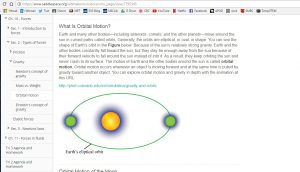What’s interesting to note here in the video titled, “A Private Universe,” is how recent Harvard graduates still don’t know why the Earth has seasons. One would think after years of post-secondary education that there would be far fewer misconceptions on this question coming from 21 out of 23 students who were interviewed. Either, these students still don’t understand after being taught why Earth has seasons, or they missed school that day. This proves that misconceptions can happen to anyone, from any educational background. Aguirre, Haggerty and Linder (1990) realize that children bring their own theories on how things work and on the world into the science classroom and us educators have to recognize this and embrace it. As in the case with Heather.
For Heather, she had many misconceptions about Earth Science. For one, she believed the orbital path of the Earth around the Sun is in a figure eight movement. Why does she think this? At first, she has no idea and then remembers that she saw another diagram from her science textbook about something different and assumed this orbital path was for the Earth too. Posner, Strike, Hcwson and Gertzog (as cited in Shapiro and Bonnie, 1988, p. 99) presented a great argument; that learning is a rational activity where learners make their judgements solely based on the evidence available at the time. I agree with this statement. Learning needs to be inquiry based. For example, every science unit I teach to my students I have a wonder wall where they ask questions that they want to know the answer to. I hope over the course of the unit that they will have answered many of them, if not all. We use science interactive notebooks, have guest speakers, conduct experiments and ask each other questions. There are times where I will teach facts, but mostly I want my students to learn through inquiry.
Posner, Strike, Hcwson and Gertzog (1982) have outlined student’s misconceptions through a process called conceptual change. More specifically assimilation and accommodation. With assimilation, students use existing concepts and theories to deal with new phenomena. With accommodation, student sometimes can’t grasp new concepts or ideas and thus need to reorganize his/her previously learned concepts. In Heather’s case, I believe she needed to assimilate her concepts with the new one learned on Earth’s rotation around the Sun. She had the right idea, just needed to modify the orbit to a more elliptical pattern.
Aguirre, J. M., Haggerty, S. M., & Linder, C. J. (1990). Student‐teachers’ conceptions of science, teaching and learning: a case study in preservice science education. International Journal of Science Education, 12(4), 381-390.
Posner, G. J., Strike, K. A., Hewson, P. W., & Gertzog, W. A. (1982). Accommodation of a scientific conception: Toward a theory of conceptual change. Science education, 66(2), 211-227.
Shapiro, B. (1994). What Children Bring to Light: A Constructivist Perspective on Children’s Learning in Science. Ways of Knowing in Science Series. Teachers College Press, 1234 Amsterdam Ave., New York, NY 10027
